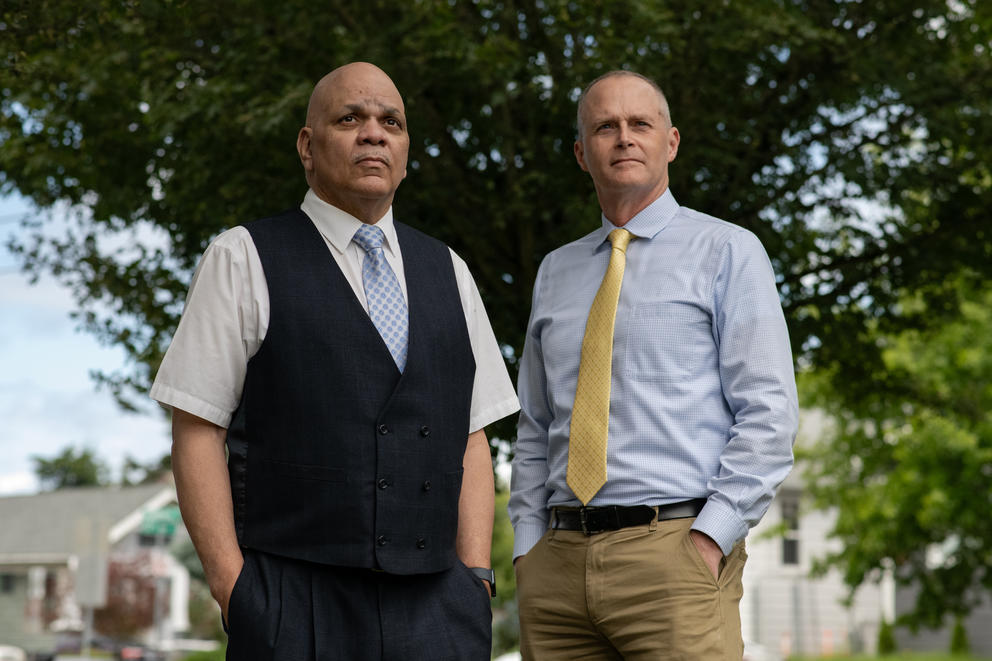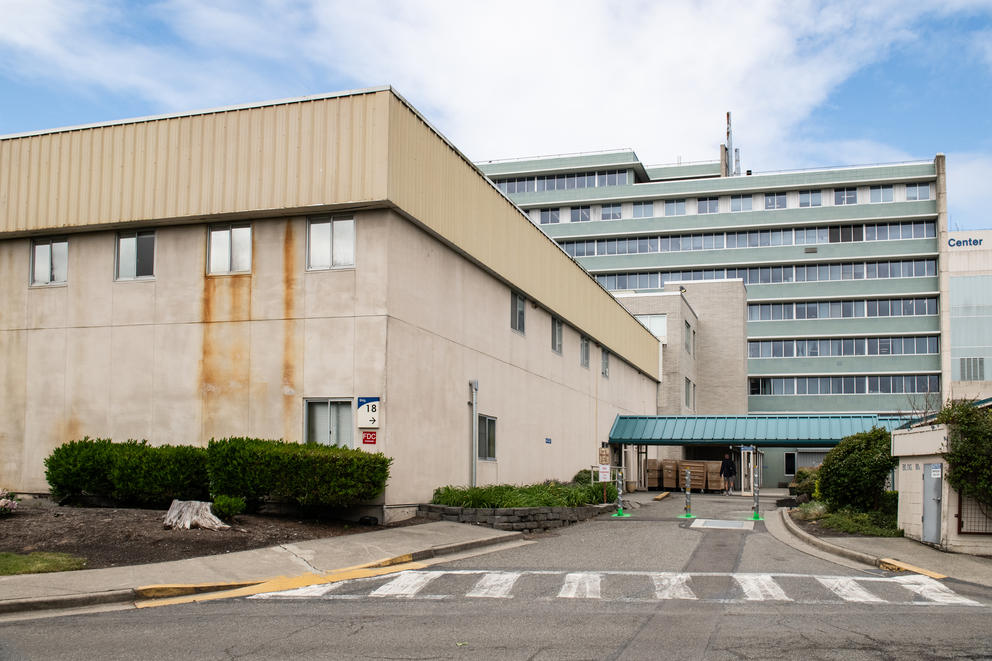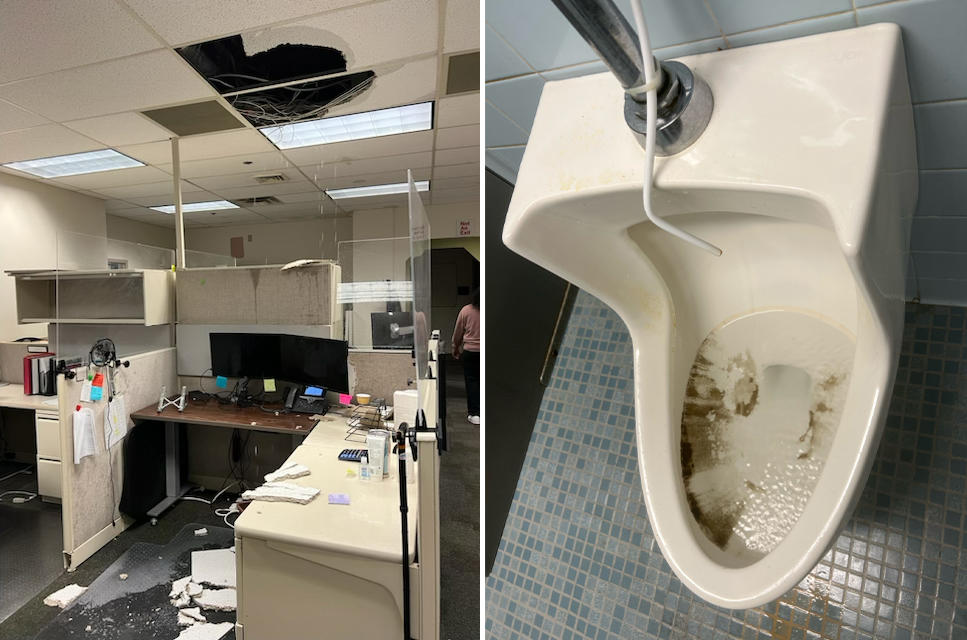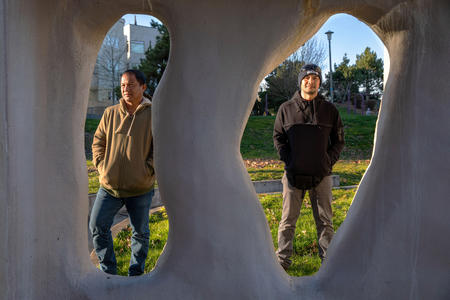There were leaks across the office that day, staffers said.
A short while later, Hopkins, the department’s deputy chief, watched another ceiling tile bulge and split under the weight of rainwater. His cellphone captured the before and after as debris again rained down.
Ceiling leaks were just one of many items on a laundry list of concerns in Building 18, which has been slated for demolition for over a decade, according to VA documents. On the first floor, the building houses offices for several departments at the Seattle VA campus. Above sits the South Clinic, which offers specialized medical services such as wound care and rheumatology.
“Every time [logistics staff] complained, it just fell on deaf ears,” Hopkins said. “No one made an attempt to move these people. And they felt devalued, underappreciated.”
This story was reported in collaboration with Northwest Public Broadcasting. Listen to NWPB's audio report.
Patients and staff have endured years of deteriorating conditions as administrators deferred maintenance and extended deadlines for moving operations out of the building. Overtaxed ventilation systems have left the facility cold in the winter and stuffy in the summer, with the VA acknowledging a lack of proper air circulation during the COVID-19 pandemic.
Staff also shared photos of moldy and water-damaged work spaces they fear endanger patients and pose public health risks. Union representatives described the conditions to Cascade PBS and Northwest Public Broadcasting as “shocking.”
VA press secretary Terrence Hayes emphasized via email that the agency’s top priority “is to provide Veterans with the health care they deserve in the most comfortable environment possible,” and that administrators plan to finish vacating the building in the next couple of months, after many delays.
The agency also said the building has not had any issues with mold, including black mold, and that the building remained “part of the scheduled maintenance calendar.”
Hayes explained that the difficulty of moving clinical space while juggling patients had delayed the original timeline.
In the meantime, six of the nine South Clinic specialties and two of the four support offices remain operating in the building, according to the VA.
Cyril Miller, an Army veteran who receives care at the Seattle VA, said he often had to keep his coat on in the winter when he would go to Building 18 for medical visits. Miller recalled once seeing a big black spot on the wall inside the South Clinic. When he asked a staff member about it, he said she told him it was mold and that it was all over the place.
“All I know,” he said, “is that building was completely unacceptable, in my opinion, for health care.”
Deteriorating conditions
South of Seattle’s downtown, atop Beacon Hill, is the sprawling 44-acre VA campus. It’s the largest medical facility in the VA Puget Sound system, with over 600,000 patient visits in 2022.
The campus got a $122 million addition in 2019. The boxy glass tower glistens above a sea of beige and white buildings, some of which date back more than 70 years — including Building 18, which has housed medical clinics since at least 1997, according to the VA. For years, including through COVID, it housed the South Clinic.
In 2017, the VA “ceased putting significant funds into maintaining a building that was going to be demolished in the ‘very near future,’” according to VA documents. The building’s heating, ventilation and air conditioning system was flagged for replacement as far back as 2004, with one assessment describing it as “failing.”
Hopkins, who began working at the VA in February 2020, said he does not remember having a working HVAC system in the building. Two other staffers also recalled that it stopped working before COVID.
Douglas Galuszka, chief of logistics, said he remembers the uncomfortable working conditions. In the winter, staffers wore their coats. In the summer, when inside temperatures could reach 90 degrees, staff opened windows and brought in fans.
The VA stated in an email that the building’s heating and cooling systems are operable, though, due to age, they are often unable to keep up with more intense temperature variation.
An HVAC system also circulates air. The VA determined in December 2021 that the HVAC failed to meet air-exchange requirements, according to Hayes. The agency’s HVAC design manual stipulates that air needs to be replaced by circulation six times per hour in patient care rooms. For office spaces, it’s four times per hour.
An air flow reading done by the VA in the South Clinic on May 18, 2022, found that of nine rooms tested, only one met VA requirements. The report specifically called out the lack of exhaust in the locations tested: “What is particularly noteworthy is that there is zero exhaust from any of the rooms.”
“The ability for the building HVAC system to maintain an acceptable air-exchange rate was one of the driving factors behind our decision to demolish,” Hayes wrote in an email. “While not achieving optimal air exchange rate, the HVAC is operational.”
To make up for the lack of required airflow during the pandemic, the VA said that the agency implemented measures such as physical distancing.
Hopkins and Galuszka said they suspect the lack of air exchange may have contributed to building staff members catching COVID-19 multiple times. During the pandemic, the respiratory virus sent at least two logistics staffers to the hospital, they said.
Other issues arose. Pest control was needed to get rid of ants, according to Hopkins, and a tree began growing through the floor of the building in the offices. He said staffers blocked it with a filing cabinet.
Then came mold, several staffers relayed. They said they started seeing what looked like “black mold” in the office space in May 2023. Galuszka’s pictures taken that summer show a dusting of a dark and powdery substance coating a ceiling vent and streaking down the side of a urinal.
The mold was a major concern to Galuszka, who said he worried that without proper air exchange, mold could proliferate across the building and cause respiratory issues.
“I just can’t see how that could be a healthy environment for anybody to be in,” Galuszka said.
The VA hired an outside company to test for mold on June 26, 2023. Results obtained by NWPB and Cascade PBS showed that the indoor air samples had significantly lower total spore counts compared to the baseline samples taken outside the building. The test found no evidence of black mold or air quality issues.
This was the only mold test taken at the building in 2023, according to a records request made to the VA.
If mold is seen or smelled, it should be removed, according to the Centers for Disease Control and Prevention. The agency’s website states that you cannot rely on sampling to determine if someone will become sick, as health effects of mold can be different for everyone. There are no set standards for acceptable quantities of mold in a home.
“You can see the black mold in the carpet, in the toilets and the urinals,” Hopkins said. “It’s so bad you have to go to a different building to use the bathroom.”
Left: Following a November rainstorm in Seattle, leaks caused ceiling tiles to bulge and break onto a desk and the floor of the logistics office in Building 18 on the Veterans Affairs Puget Sound Health Care System campus. (Courtesy of Cortez Hopkins) Right: Apparent mold streaks down the side of a urinal. According to Douglas Galuszka, chief of logistics who provided the photo dated June 7, 2023, it was taken in a bathroom in Building 18 on the Veterans Affairs Puget Sound Health Care System campus. (Courtesy of Douglas Galuszka)
Missed deadlines
While the structure has been long scheduled for demolition, VA leadership began planning to vacate Building 18 in the summer of 2023. An initial plan set Aug. 7 as a start date for moving out some operations. Staff said leadership then pushed the vacate deadline to the end of the year. Then to June 2024.
The VA, after acknowledging they missed the end-of-the-year move-out date, now estimates it will take a couple months more.
Amid last summer’s relocation planning, the director of safety at VA Puget Sound, Anthony Phillips, recommended in an email that staffers vacate the building.
His Sept. 7 email stated that the building was deemed safe as there were “no recognized or identified risks to the physical structure of the building,” and that mold levels had been found to be within acceptable ranges.
However, Phillips wrote that the building conditions are “significantly uncomfortable.”
“The current conditions are impacting the overall morale and ‘psychological’ safety of these employees,” he wrote. “Therefore, the Safety Office recommends these employees be relocated as soon as possible to a location with conditions deemed acceptable and reasonable.”
As logistics staffers waited to be moved, several wrote to their congressional representatives asking for help moving out of Building 18. VA documents acknowledge that at least five such letters were sent.
One letter, dated Oct. 26, 2023, states, “I and my fellow employees work in the most horrible conditions. The building we work in has no heat, no air circulation and no air conditioner in the summer time.” This text is capitalized in the original letter.
Galuszka and Hopkins later accused VA leadership of retaliating against some Building 18 staff over these letters to congressional leaders. The two alleged that logistics staff were singled out, and only they were told to move some of their staff off-campus to a rented space on East Marginal Way in South Seattle. Galuszka and Hopkins said they argued staffers needed to be physically on site to do parts of their job, and that there was available space in other nearby buildings.
After the November rainstorm that took down ceiling tiles, logistics staff began moving out of the building.
A March 14 fact-finding report concluded there was no evidence of retaliation, but did acknowledge the frustration and distrust staff could have with leadership, given years of problems.
The American Federation of Government Employees (AFGE) Local 3197 represents VA Puget Sound employees. Union president Beverly Anderson helped with the move negotiations. She said it was a struggle to come to a resolution between VA leadership and Building 18 employees. But, Anderson said, she was under the assumption after speaking with leadership in December that they would have everyone, the clinic included, out by the end of 2023.
“Some people were asthmatic, some people just had immune systems that were compromised by the mold, and they could feel it,” Anderson said. “They were calling in sick because of it. So, the move had to happen.”
Clinic still operating
In early May, prompted by questions from NWPB and Cascade PBS, Anderson and union vice president Peter Hranek toured Building 18.
As Anderson walked down the hallway leading to the South Clinic, they passed long white hoses that snaked down from the ceiling and emptied into blue buckets on the floor to collect rainwater. She snapped photos of the buckets, as well as of portable heaters.
The next day, Anderson flipped through photos on her phone, tapping the screen for emphasis. She and Hranek shook their heads as they described the disarray patients faced at the clinic.
“You can see all the water stains on the ceiling, you can see just the terrible condition of the carpet,” Hranek said. “Water stains everywhere.”
While some specialty clinics still remain open in Building 18, the VA said the agency is on track to complete the relocation in the next few months.
Before coming to work for the union, Hranek was a registered nurse at the hospital.
He said he worries that patients who come into the South Clinic seeking care could have any number of compromising health conditions that could make them even more vulnerable to illness from the lack of air circulation and potential exposure to mold.
“Every time I walk down that hall, I’m like, ‘Really, there’s still clinics in there,’” Hranek said. “It’s shocking.”
In the basement during their walk-through, Anderson and Hranek said they encountered someone who asked them, “When are we getting out of here?”
“The South Clinic should have been closed months ago,” Anderson said. “Leadership is dragging their feet in getting it done. But I’m gonna light a fire. Because it’s got to happen. Those people need to get out of there.”
Get the latest investigative news
A newsletter for resources, data and behind-the-scenes insight into investigative efforts.









